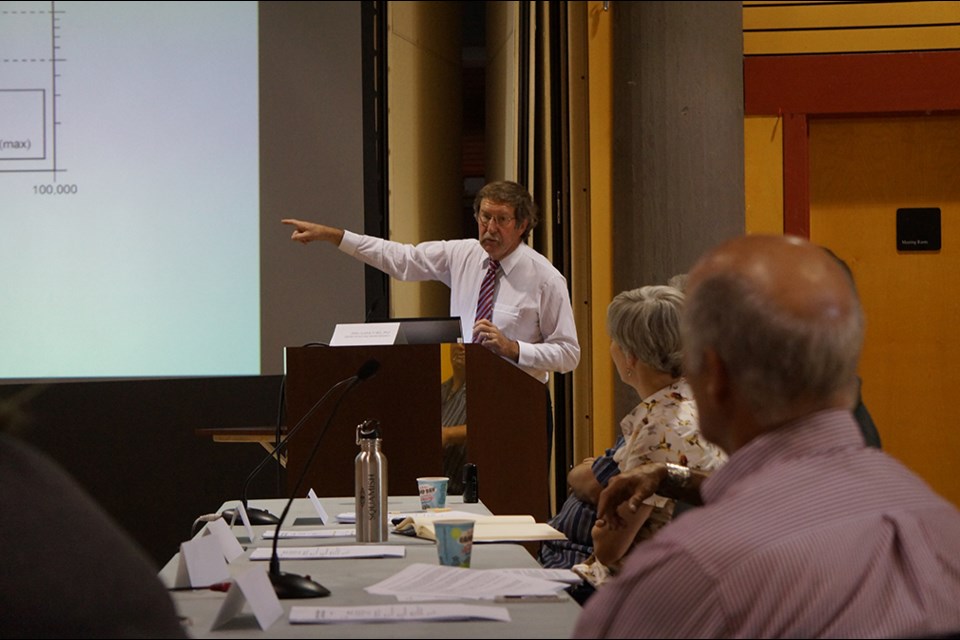It all comes down to how much risk to human life the district is willing to accept.
The recently released second Cheekye River and Fan expert review panel report helps stakeholders determine options to mitigate the risk of a catastrophic landslide to people living on the Cheekye Fan. The report, Cheekye River and Fan Landslide Risk Tolerance Criteria, was presented at a joint committee of the whole meeting with the Squamish Nation and the District of Squamish, held Tuesday at Totem Hall.
“You cannot have zero risk if you live in the mountains,” said John Claque, geologist and natural hazard expert who presented the report.
“People may expect that there is absolutely no risk from landslides, but inevitably there is some and the issue that we face societally is how to minimize that risk to allow a balance of societal values.”
In deciding what type of mitigation is needed, the second panel recommended the district adopt the Hong Kong landslide risk tolerance criteria: individual yearly risk of fatality or injury to a person within the danger area should be less than one-in-10,000 chance for existing development and less than one-in-100,000 for new development.
Squamish’s Official Community Plan prohibits development on a large portion of the Cheekye Fan.
Squamish’s Cornerstone Developments Ltd (of which the Squamish Nation is a partner) has proposed a 750-unit development that includes a childcare facility and a private school on 178 acres within hazard zones on the fan, southeast of the Squamish Airport. The proposal includes an approximately 35-metre high debris flow barrier and other landslide mitigation works, but the cost of operation and clean up of the barrier would fall primarily to the district.
An Official Community Plan (OCP) amendment to allow the development proposal passed first reading at District of Squamish council in early March, but passage was against the recommendations of district staff and came only after an impassioned speech by a Squamish Nation representative.
This second report confirmed the assertions of other papers that have been completed on the fan, including the first expert panel report, tabled in 2014, saying something has to be done about the landslide risk on the fan, regardless of whether or not the proposed development proceeds.
“There is, in our opinion an unacceptable level of risk on this fan,” said Claque. “There is an unacceptable risk to the First Nations communities in terms of injury –life threat – but there is also an unacceptable risk to infrastructure, to the highway, to the bridges along the highway and to other facilities that currently exist along the fan.”
Three Squamish Nation villages are located on the fan.
The first report showed that a worst-case scenario could see a landslide of 5.5 million cubic metres of debris – or enough material to fill BC Place twice – come hurtling down Mount Garibaldi with very little time for people to escape.
Squamish Nation hereditary Chief Gibby Jacob said because the risks are known, there is a responsibility for leaders to act.
“You know the cause, you know the effects and you know that something has to be done. There is no way around it – whether it be the provincial government, the municipal government, or our government.”
Gibby said Nation families that live on the fan, including his own, will not move.
“It is where their roots are. The outside world, you come and you go… but our people belong to those lands and the lands belong to them,” he said.
Portions of Brackendale, including two schools, are on the southwest portion of the fan. The Squamish Airport and the BC Hydro Cheekye substation are also on the fan, plus a rail line and Highway 99 cross the fan.
How much risk the community is willing to take in terms of the possibility of potential deaths from landslide events will determine what options to take for the Cheekye, Claque said.
“It is ultimately your responsibility to select evaluation parameters… and to ultimately make a decision as to what level of residual risk you’re willing to tolerate,” Claque said.
He said that people are much more willing to accept voluntary risk as opposed to an involuntary risk such as from a landslide.
There is a one-in-200 chance annually of dying from smoking and a one-in-500 risk of dying from canoeing, according to the report.
The report recommends all mitigation options be considered for the Cheekye fan, including debris barriers, berms, and land-use zoning, signage and education.
“I don’t think that we need to get stalled in terms of not knowing exactly what the perfect thing to do is,” said Councillor Jason Blackman Wulff, who lives on the fan himself.
“We need some action and we can always make additions to improve something that is constructed and I think that we can come to something that is a win-win.”
Mayor Patricia Heintzman said, adding that the crux of the issue is what level of risk tolerance is acceptable, but also what cost the community is willing to bear financially.
“We need to understand the cost [of mitigation] on a yearly basis – operational, maintenance, that type of thing, the potential replacement costs 20 years, 30 years, 75 years down the road and whether or not the existing citizens, let alone new citizens, can afford that, and that is really challenging,” she said.
“We all know there is existing risk and we all know the existing risk is unacceptable, we all know we have to figure out mitigation… once we determine risk tolerance we will understand those costs better.”




